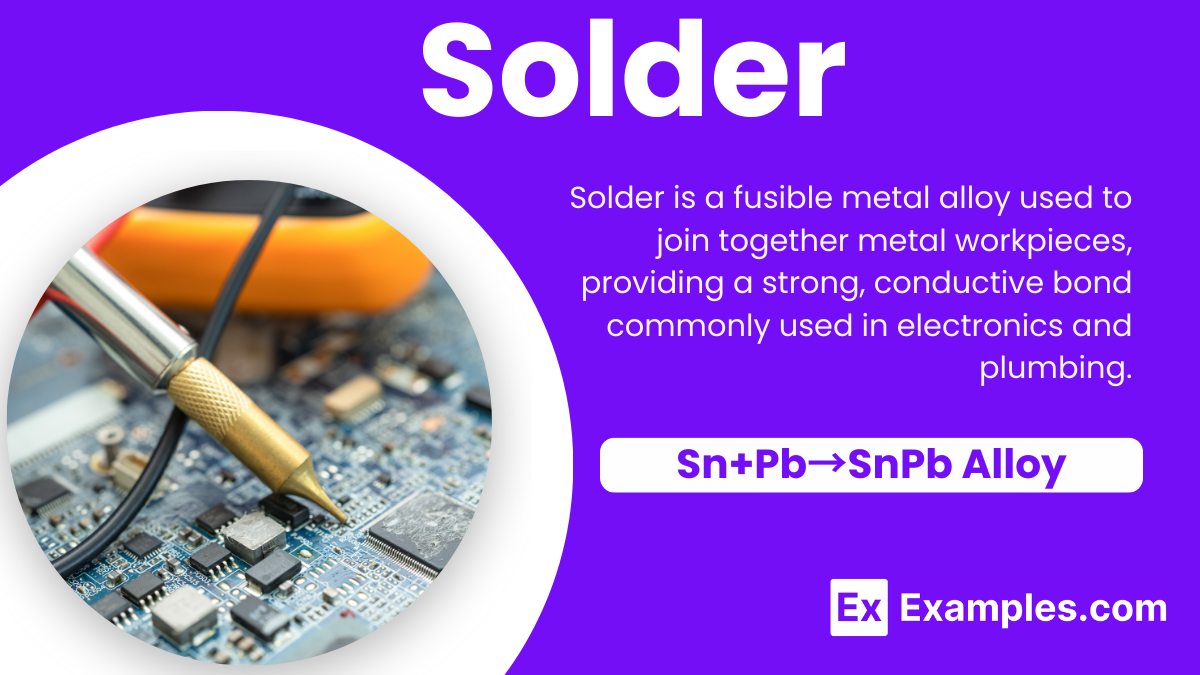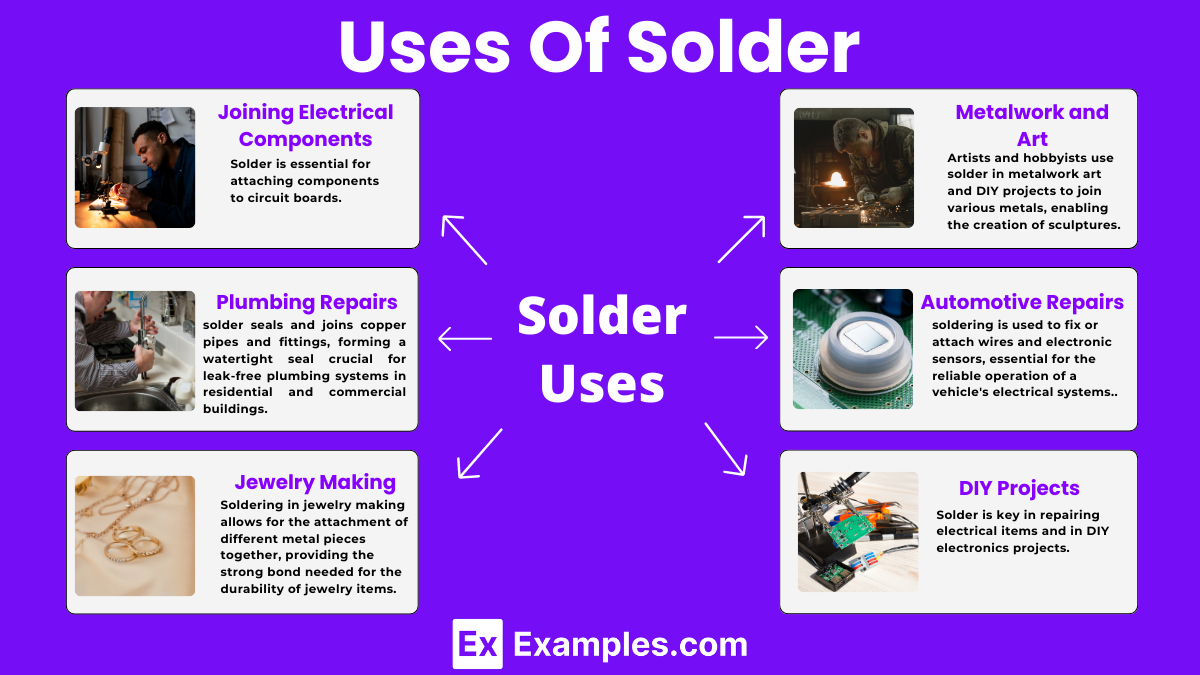What is solder primarily used for in electronics?
To clean electrical components
To join electronic components together
To insulate electrical wires
To cool down electronic circuits

Solder is a metallic compound that plays a vital role in the world of chemistry, especially when it comes to joining two metal pieces together. This unique substance is crafted from a blend of metals, typically lead and tin, which allows it to melt at a relatively low temperature. When heated, solder becomes a liquid that can flow into tiny gaps between metal parts. Upon cooling, it solidifies, creating a strong and lasting bond. This process, known as soldering, is crucial for building and repairing electronics, jewelry, and various metalwork projects. Understanding solder and its properties is a fascinating aspect of chemistry, showcasing the practical application of metallic compounds in everyday life.
Solder is a type of metal alloy, which means it’s made by mixing two or more metals together to create something new. In the case of solder, it’s mainly a mix of tin and lead. This combination creates a metal that can melt at a lower temperature than either tin or lead would on their own. Once melted, solder is used to connect pieces of metal together, cooling down to form a strong bond. It’s a go-to material for building or repairing electronics, crafts, and even some types of jewelry. Think of it as a metal “tape” that can fix or create circuits and connections, making it an essential tool for many projects and repairs.
Lead-based solder has been popular for many years due to its low melting point and ease of use. It’s a mixture of lead and tin, typically in a 60/40 ratio. This type of solder flows smoothly and creates strong joints. However, due to health concerns associated with lead, its use is now limited, especially in consumer electronics.
With growing health and environmental concerns, lead-free solders are becoming the norm. These solders replace lead with other metals like silver, copper, bismuth, or zinc. Lead-free solder has a higher melting point compared to lead-based solder, which can make it slightly more challenging to work with for beginners. It’s safer for health and is used in all equipment that complies with current health and safety regulations.
Silver solder is known for its strength and is commonly used in jewelry making and in applications requiring a strong bond. It contains a higher percentage of silver, which increases its melting point and makes the joints robust against physical stress. Silver solder is perfect for detailed work where strength is paramount.
Rosin-core solder is designed for electrical and electronic work. It contains a flux in the core of the solder wire, which helps clean the metal surfaces during soldering. This flux is made from rosin, a natural resin, which reduces oxidation of the base and filler metals. It’s ideal for circuit board repairs and building electronic projects because it prevents corrosion and ensures a durable connection.
Acid-core solder is primarily used in plumbing, sheet metal work, and other applications not related to electronics. The core of the solder contains an acid-based flux that cleans the metal surfaces as it melts. This type of solder is not suitable for electrical or electronic applications because the acid can damage wiring and components.
Preparing solder, a vital material in electronics and metalworking, involves combining specific metals to create an alloy with a low melting point. For a common solder used in electronics, the tin-lead solder, the preparation process is straightforward. This solder is typically made with a 60/40 ratio of tin to lead. The formula for creating this solder is simple:
To prepare it, tin (Sn) and lead (Pb) are carefully weighed to achieve the desired ratio and then melted together in a controlled environment to prevent oxidation. Once the metals are fully melted and mixed, the alloy is cooled and solidified into the form needed for use, such as wire or bars. It’s essential to ensure a homogeneous mixture for consistent melting behavior and optimal soldering performance. For those working on projects or repairs, understanding this basic preparation can help in selecting the right type of solder for your needs, keeping in mind the shift towards lead-free solders for health and environmental reasons.
| Property | Description |
|---|---|
| Melting Point | The temperature at which solder changes from solid to liquid. Tin-lead solder typically melts at around 183°C (361°F), while lead-free solders have a higher melting point, usually above 217°C (422°F). |
| Density | How heavy the solder is for its size. Solder density varies with its composition, with lead-based solders being denser than lead-free alternatives. |
| Thermal Conductivity | The ability of solder to conduct heat. Solder generally has good thermal conductivity, essential for efficiently transferring heat during the soldering process. |
| Electrical Conductivity | Solder’s ability to conduct electricity, crucial for creating electrical connections. It is generally lower than pure metals but sufficient for electronic circuits. |
| Tensile Strength | The maximum stress solder can withstand while being stretched or pulled before breaking. Lead-free solders often have higher tensile strength compared to lead-based solders. |
| Flexibility | Solder’s ability to bend without breaking. This is important in applications where the joint might be subject to movement or vibration. |
Solder can react with oxygen to form oxides, affecting its ability to bond well. For example, when heated, tin in the solder reacts with oxygen, forming tin oxide.
Equation: 2Sn + O₂ → SnO₂
This reaction is why flux is used during soldering to prevent the solder from oxidizing and ensure a clean, strong bond.
Solder is generally resistant to both acids and bases, but can corrode over time if exposed to strong acidic conditions. Lead-based solders are especially prone to acid corrosion, a process where the solder dissolves slowly when in contact with strong acids, affecting the durability of the solder joint.
Solder is thermally stable up to its melting point. This stability is essential for forming durable joints that can withstand the heat generated by electronic devices or plumbing systems without deteriorating, ensuring the longevity and reliability of the connections.
Solder is an alloy made by combining tin with lead, or for lead-free options, tin with other metals like copper, silver, or bismuth. The combination of these metals influences the solder’s characteristics. For instance, incorporating silver into tin-based solder improves its strength and resistance to thermal fatigue, making it better suited for applications that involve high temperatures.
Though not directly a chemical reaction, the composition of solder significantly impacts its electrical conductivity. Solder provides electrical connectivity, crucial for forming electrical connections in circuits. However, it’s important to note that solder’s conductivity is less than that of the pure metals found in wires and electronic components, which is a vital consideration in designing and repairing electronic circuits.

Solder is essential for attaching components to circuit boards, creating strong electrical connections necessary for the functioning of electronic devices like smartphones, computers, and TVs.
In plumbing, solder seals and joins copper pipes and fittings, forming a watertight seal crucial for leak-free plumbing systems in residential and commercial buildings.
Soldering in jewelry making allows for the attachment of different metal pieces together, providing the strong bond needed for the durability of jewelry items.
Artists and hobbyists use solder in metalwork art and DIY projects to join various metals, enabling the creation of sculptures, models, and decorative items.
In automotive repairs, soldering is used to fix or attach wires and electronic sensors, essential for the reliable operation of a vehicle’s electrical systems.
Solder is key in repairing electrical items and in DIY electronics projects. It allows enthusiasts and professionals to fix broken connections in gadgets or create new electronic circuits, showcasing the versatility and utility of solder in maintaining and innovating technology
Solder is user-friendly, especially for beginners in electronics or metalworking. It melts at a low temperature, making it easy to work with using basic tools like a soldering iron. This ease of use facilitates quick learning and mastery of soldering techniques.
When solder cools and solidifies, it forms a strong electrical connection between components. This property is essential in ensuring that electronic devices function reliably, without interruption.
The joints created by solder are not just strong; they’re also durable. They can withstand temperature variations and physical stress, ensuring the longevity of the connections in various applications, from plumbing to electronics.
Using solder is a cost-effective method for joining metals. Compared to other bonding techniques, soldering requires less energy and lower-cost equipment, making it accessible for DIY projects and professional applications alike.
Solder can be used on a wide range of metals and in various fields, including electronics, jewelry making, plumbing, and automotive repair. This versatility makes it an invaluable tool in both industrial and hobbyist settings.
One of the significant benefits of solder is that it allows for easy repairs. If a joint fails or a component needs replacement, the solder can be melted again, the repair made, and the joint re-soldered, extending the life of the device or item.
Yes, solder is commonly an alloy of lead (Pb) and tin (Sn), used in electronics and plumbing for creating strong, conductive joints.
No, solder is not an alloy of iron. It primarily consists of tin and lead, or other metals for lead-free versions, designed for low melting points.
Solder 60/40 refers to an alloy composed of 60% tin and 40% lead, known for its reliable melting behavior and good wetting properties in soldering applications.
Text prompt
Add Tone
10 Examples of Public speaking
20 Examples of Gas lighting
What is solder primarily used for in electronics?
To clean electrical components
To join electronic components together
To insulate electrical wires
To cool down electronic circuits
What is the primary material used in traditional solder?
Silver
Lead
Copper
Zinc
What is the purpose of flux in soldering?
To clean the soldering iron
To prevent oxidation
To cool the solder
To increase the solder's melting point
Which soldering technique involves melting solder with a soldering iron?
Wave soldering
Reflow soldering
Hand soldering
Dip soldering
What is a common alternative to lead-based solder for environmentally friendly soldering?
Gold solder
Tin-silver-copper solder
Aluminum solder
Nickel solder
What does the term "solder joint" refer to?
The connection between two wires without solder
The area where solder has melted
The solidified area where solder bonds two components
The cleaning process of solder
What is the main purpose of a soldering flux?
To increase the electrical resistance
To remove solder residues
To improve solder flow and adhesion
To increase the temperature of the soldering iron
Which of the following is a common type of solder used in plumbing?
Silver solder
Gold solder
Aluminum solder
Tin-lead solder
How does a soldering iron transfer heat to the solder?
Through a chemical reaction
By convection
By conduction
By radiation
What safety precaution is important when working with solder?
Wearing gloves
Using a fume extractor
Working in a dark room
Avoiding protective eyewear
Before you leave, take our quick quiz to enhance your learning!

